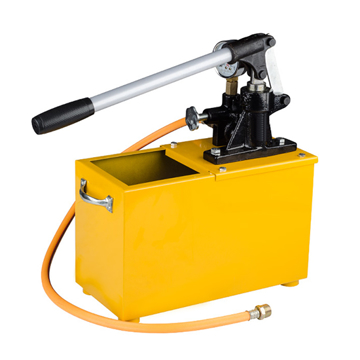Pressure Test Pump
Manual Pressure Test Pump, 2.5~6.3MPa
Manual Pressure Test Pump, 1.6~40MPa
Manual Pressure Test Pump, 5/10 MPa
Electric Pressure Test Pump, 2.5~10MPa, 0.2~0.5 HP
Electric Pressure Test Pump, 2.5~10MPa, 1.0/1.2 HP
What is a Pressure Test Pump?
Pressure test pump is a testing machine for hydraulic testing (hydro test) and obtaining high-pressure liquids in the laboratory. Hydraulic test pump is designed for various pressure vessels, pipelines, valves, boilers, cylinders, fire-fighting equipment, plumbing, etc.
Generally, pressure test pumps are divided into manual pressure test pumps, electric pressure test pumps, pneumatic pressure test pumps, hydraulic pressure test pumps, diesel pressure test pumps, numerical control pressure test pumps and so on.
Hydrostatic test pump is a kind of pressure test pump. In fact, they can be regarded as the same pressure tester machine, which can be used to test water meters, pipes, pressure vessels, solar systems and sprinkler systems in residential and commercial buildings.
Pressure Test Pump Working Principle
Basic structure of the pressure test pump includes the pump body, plunger, sealing ring, control valve, pressure gauge, water tank, etc. Before use, do the calibration work for pressure gauge to ensure reliable pressure coefficient.
- Manual Pressure Test Pump
When the plunger is lifted by handle, a vacuum is generated in the pump body. The inlet valve is opened, and the clean water enters pump body through the water filter and the inlet pipe. When handle is pressed down, the water inlet valve is closed, and the water outlet valve is opened to output pressure water, then enter the device under test. Work reciprocally in this way to achieve the rated pressure test.
- Electric Pressure Test Pump
The function of electric pressure test pump is to convert the mechanical energy of power machines (such as electric motors, internal combustion engines) into liquid pressure energy. The cam is rotated by motor. When the cam pushes the plunger upward, the seal volume formed by plunger and cylinder decreases. The oil is squeezed out of the sealed volume and discharged through the one-way valve. When the cam rotates to the lower part of curve, the spring forces the plunger down to form a certain vacuum. The oil in tank enters the sealed volume under the action of atmospheric pressure. The cam makes the plunger rising and falling continuously, the sealing volume periodically decreases and increases, and the pump continuously sucks and discharges oil.
Pressure Test Pump Selection
If you need low pressure testing on a relatively small system, a manual pressure test pump is enough. Selecting an electric pressure test pump can replace manual labor with electricity, which is efficient and convenient. The following are recommendations for the selection of electric pressure test pumps.
|
Application Place |
Pipe Diameter (mm) |
Model Recommendation |
|
Home decoration/office space |
Φ32, Φ25, Φ20, Φ16 |
|
|
Construction site/villa/floor heating |
Φ50, Φ40, Φ32, Φ25, Φ20, Φ16 |






